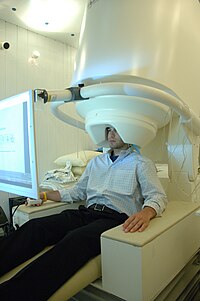
Photo from wikipedia
BACKGROUND Recent progress in optically pumped magnetometers (OPMs) and high-temperature superconducting quantum interference devices (SQUIDs) has facilitated the development of an on-scalp magnetoencephalography (MEG) system that offers high signal intensity… Click to show full abstract
BACKGROUND Recent progress in optically pumped magnetometers (OPMs) and high-temperature superconducting quantum interference devices (SQUIDs) has facilitated the development of an on-scalp magnetoencephalography (MEG) system that offers high signal intensity and flexibility at a lower cost. While the on-scalp sensor array has high flexibility, it brings new challenges to accurate sensor-to-brain coregistration, which is essential for MEG source localization. NEW METHOD A novel automatic filtering algorithm based on plane segmentation was proposed to locate on-scalp MEG sensors in 3D images reconstructed from optical scanning. Global image registration was employed for the automatic alignment of anatomical images and sensor positions. RESULTS Seventy-one sensor dummies on the scalp were located and registered to brain anatomical images. The deviations of the sensor location and orientation from the averaged result of 10 measurements were less than 1 mm and 0.6°, respectively. The entire process could be completed in less than 4 min. COMPARISON WITH EXISTING METHODS Compared with existing methods that involve various manual procedures, such as moving digitizers to fiducials and repeatedly pulling out sensors, our proposed coregistration method is more efficient and accurate. CONCLUSION An automatic method for the coregistration of anatomical structure and on-scalp sensors that will have a large impact on the practical use of on-scalp MEG is developed.
Journal Title: Journal of Neuroscience Methods
Year Published: 2021
Link to full text (if available)
Share on Social Media: Sign Up to like & get
recommendations!